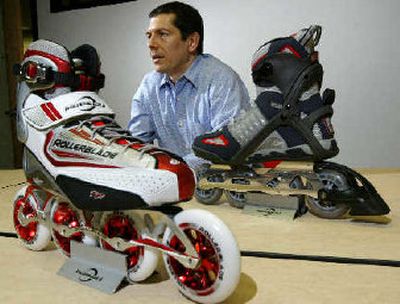Keeping boomers in-line

HAMILTON TOWNSHIP, N.J. — The kids and young adults who were trying out in-line skating during its heyday are entering their 40s and 50s today.
And officials at Rollerblade, now owned by Italian sporting goods manufacturer Tecnica Group, want to remind those aging boomers that in-line skating isn’t just for teens and isn’t just for fun — it’s good exercise too.
Just ask Rollerblade founder Scott Olson. Now 46, Olson, who lives in the Minneapolis suburb of Waconia, says he gave up in-line skating for seven or eight years to concentrate on other projects.
That changed a year ago after a local television station asked him to lace up.
“I finally dug up an old pair at my house and skated around for them for about 10 minutes, but boy, I was going through a whole lot of hurt,” he said. “I decided maybe I should start doing this again more often.”
As Rollerblade marks it 25th year, company officials are hoping an emphasis on fitness will help it expand beyond its core customer base of young people.
“People in their 40s and 50s are now willing to use it (in-line skating) as a fitness activity because they are comfortable with it,” said Jeremy Stonier, vice president and general manager of the company based in the Trenton suburb of Hamilton Township.
The company is sponsoring in-line skating marathons, school programs and free skating lessons to promote its claim that the activity burns as many calories as running or cycling, but with less impact and shock to joints.
Stonier said 2004 was the company’s most profitable year since 1998 and that it’s on track for a 10 percent sales increase in 2005. Rollerblade says its emphasis on physical fitness is designed to reverse a decline in the sport’s popularity since the late 1990s.
The activity reached its peak in 1998, when 32 million Americans over 6 said they had tried in-line skating at least once during the year, but the novelty then started to wear off. By 2004, only 17.3 million had tried it, according to the Sporting Goods Manufacturers Association.
Sales in the industry reflected the trend. In 2003, manufacturers sold $145 million worth of in-line skating equipment in the United States, down 30 percent from the year before.
Stonier, who took over as general manager in 2003, acknowledges that Rollerblade itself struggled during the years it was owned by Benetton Group, the Italian apparel company.
“It just wasn’t the greatest of fits, literally,” he said. “It was a company focused on clothes and other items that wasn’t as interested in sporting goods.”
Even so, Rollerblade had already begun to go back to basics before the company was bought by Tecnica Group two years ago. Focusing on user friendliness, Rollerblade skates now boast such features as laces that tie with a drawstring pulled in the back and children’s boots that adjust in size with a push of a button for growing feet or sharing with a sibling.
Out of its 33 models, Rollerblade still has skates with names like Lightning and Aero that are geared for both fitness and thrill-seeking, as well as its Team Rollerblade Series for stunt skaters. The company also has models such as the Zetrablade, tailored for beginners looking for a workout.
Company officials say efforts are starting to pay off. They claim the company has been able to double its market share to about 60 percent in the past five years.
Rollerblade has been able to maintain worldwide sales at about 2 million skates per year, about $100 million worth, with half the skates sold in the United States, Stonier said.